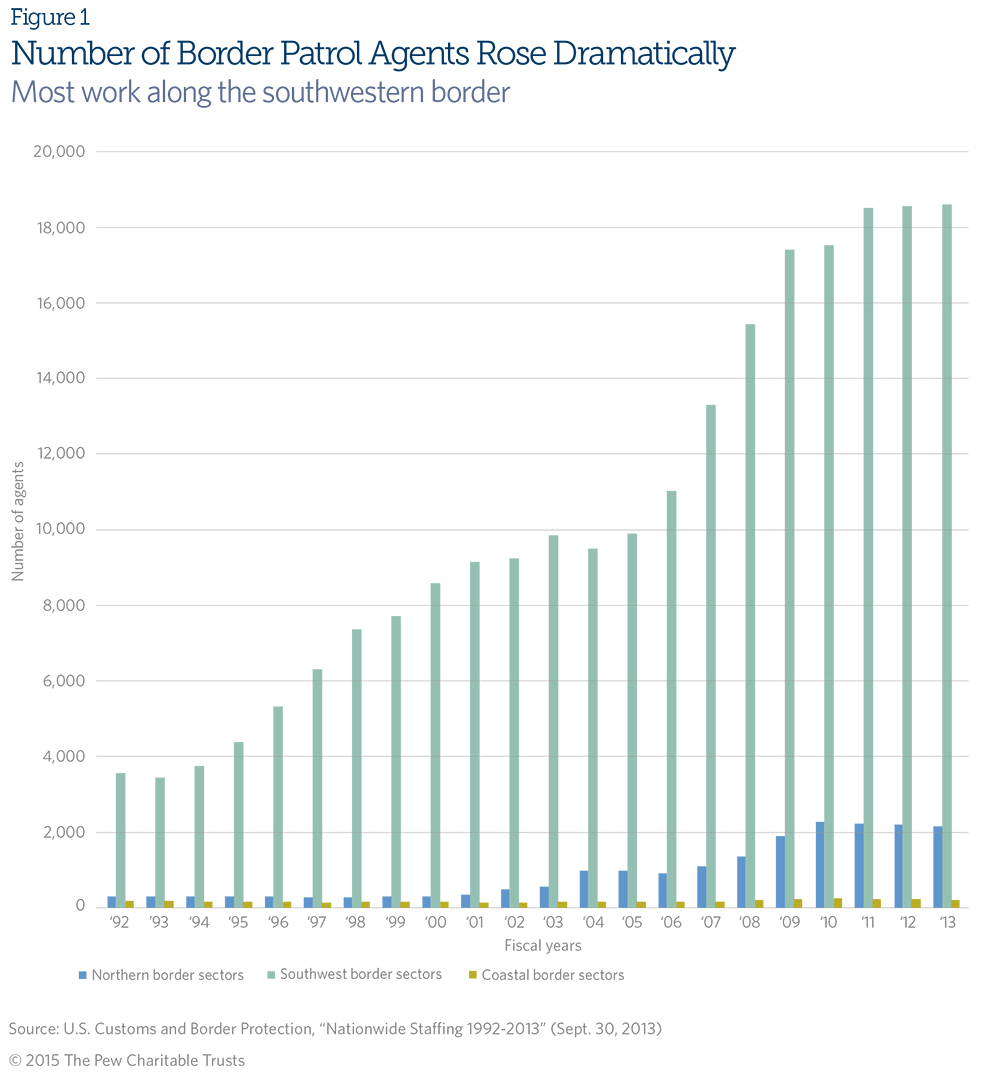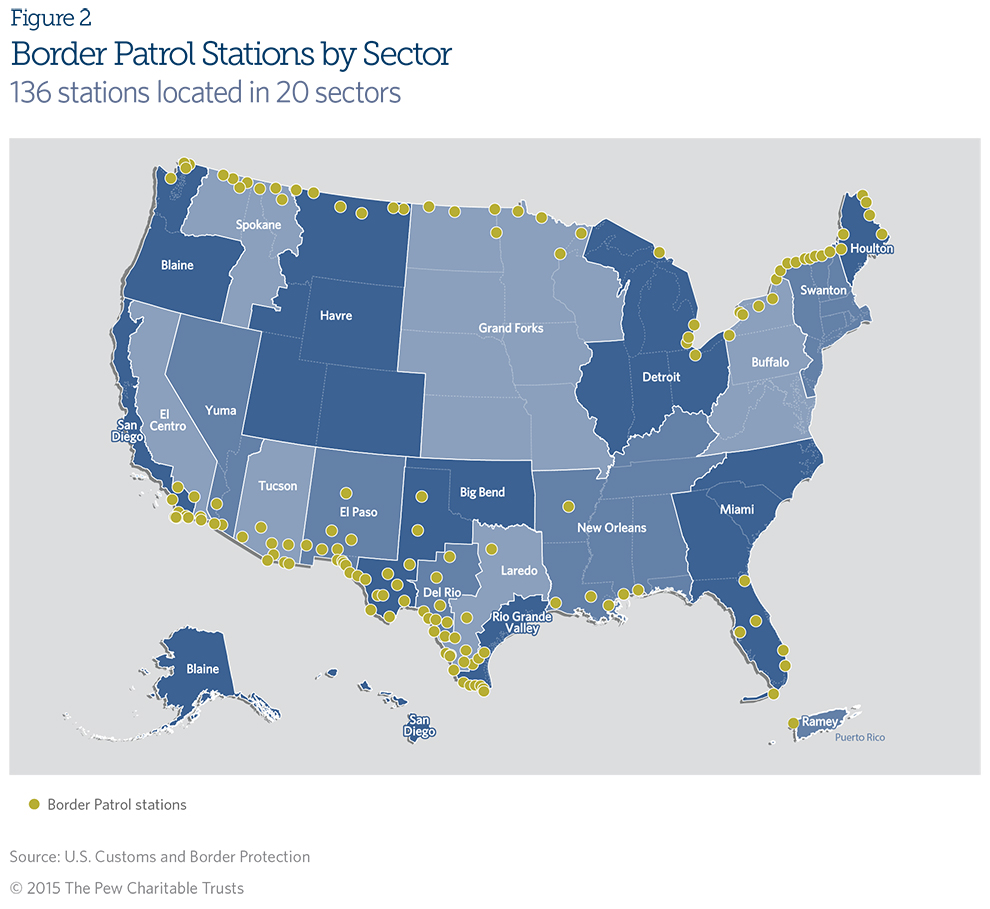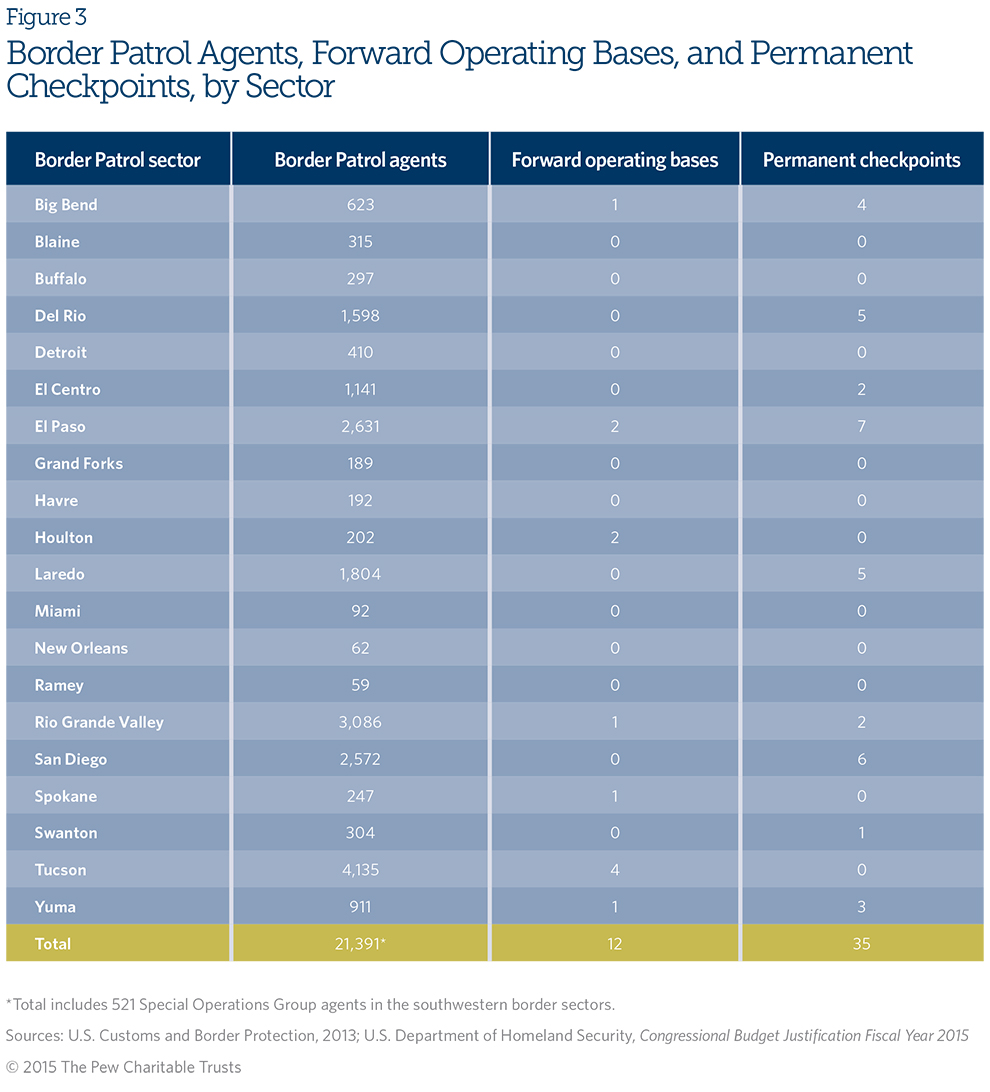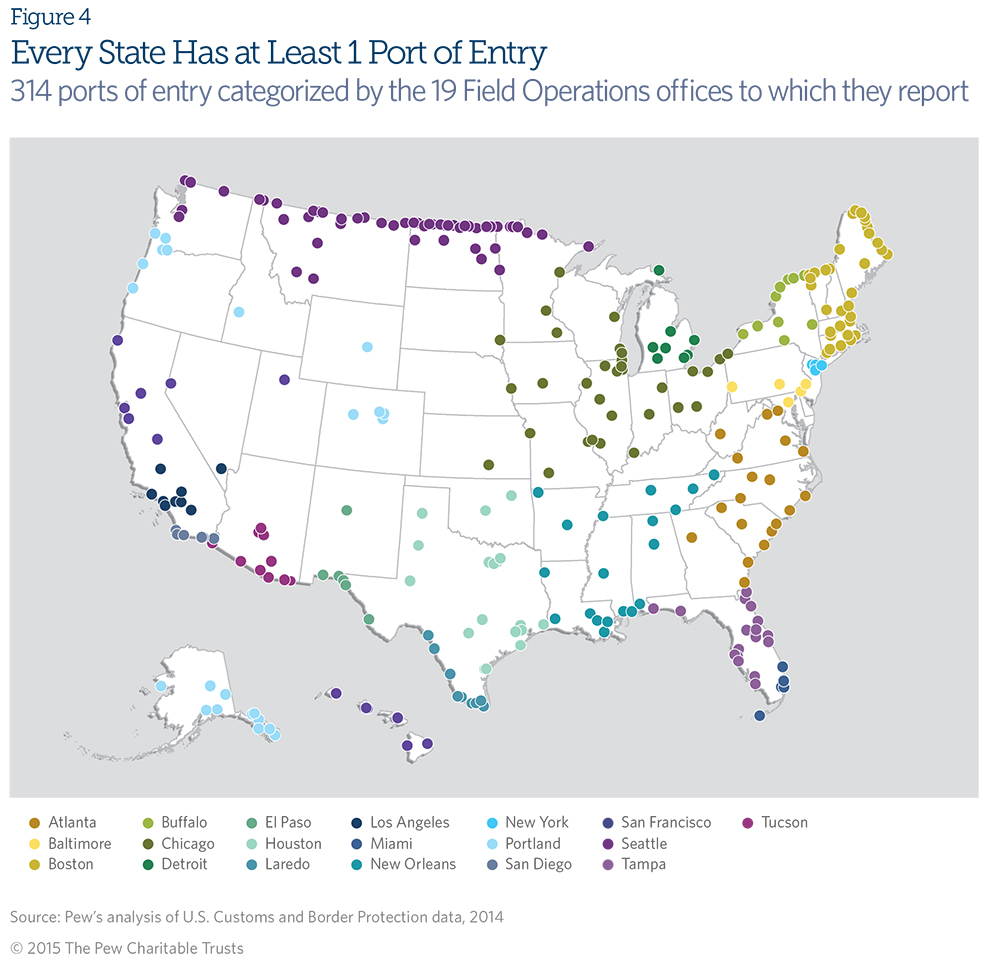Immigration Enforcement Along U.S. Borders and at Ports of Entry
Federal, state, and local efforts
Overview
The federal government processed 362 million citizen and noncitizen travelers through U.S. ports of entry in fiscal year 20131—more than 242 million people by land, 102 million by air, and 18 million by sea.2 That year, authorities apprehended some 421,000 people trying to enter the country illegally outside those official ports.3
Border security is primarily a federal responsibility and involves managing the legal flow, and preventing the illegal entry, of people and goods into the United States. In recent years, though, state and local authorities increasingly have collaborated with federal agencies on immigration-related efforts at the nation’s borders. This brief explores the federal, state, and local work in enforcing immigration laws at those borders and ports of entry. The Pew Charitable Trusts addressed similar issues in the country’s interior in a July 2014 brief, “Immigration Enforcement Within the Nation’s Borders.”
In discussions of immigration and border security, attention often focuses on the 1,954-mile land border between the United States and Mexico. Yet the federal agencies involved in immigration enforcement have personnel and operations at other U.S. borders and at ports of entry in all 50 states. Over the past two decades, increased federal funding for border security has meant more facilities, equipment, and personnel devoted to this mission. Since the creation of the Department of Homeland Security (DHS) in 2003, funding for U.S. Customs and Border Protection, the agency that manages the nation’s borders, has risen from $6.6 billion4 to $12.4 billion in fiscal 20145—in real terms, a 91 percent increase.
There also have been expanded attempts to coordinate activities with state and local law enforcement. Although no nationwide program of border cooperation exists, pockets of activity and examples of collaboration are evident along land borders. Over the past decade, partnerships, programs, offices, and task forces have been started to share information and coordinate law enforcement efforts among various levels of government.
The relationship between states and the federal government received heightened national attention in 2014 as some states put additional resources into border enforcement in response to an increasing number of unaccompanied children illegally crossing the southwestern border. In July, for example, Texas sent 1,000 members of the National Guard to its border with Mexico to reinforce federal efforts.
Though federal agency operations span many border security missions, including protecting the nation from terrorism, illegal drugs, and the unlawful entry of goods, this brief focuses only on the entry of people. The figures presented here on staffing and funding include roles beyond that mission, however, because it is often not possible to isolate resources dedicated to specific activities.
This brief is not meant to be an exhaustive accounting of federal and intergovernmental activities at the border and ports of entry. Instead, it provides examples demonstrating that border security is, in reality, occurring not just at the land borders with Mexico and Canada, but all across the United States, and that there are places where different levels of government are collaborating to address security concerns. Understanding the geographic breadth of these efforts can give policymakers a broader and more complete picture of immigration-related border enforcement activities.
Pew takes no position on federal, state, or local laws or policies related to immigration.
Defining the Border
The definition of the border for federal immigration enforcement purposes is broad. Activities take place along international land boundaries. Border enforcement also takes place at many seaports and along the coastline. Related maritime operations occur along the northern border on the Great Lakes and St. Lawrence Seaway, and around U.S. territories, such as Puerto Rico.
In addition, border enforcement exists well inside the United States at international airports and up to 100 miles inside the physical border with Mexico or Canada, where U.S. Customs and Border Protection has the authority to operate checkpoints and transportation checks.
Key federal agencies and personnel
Many federal agencies have a presence across the states in enforcing immigration laws at the borders and at ports of entry. DHS and the Department of Justice are the key federal actors in immigration-related border security, but other federal agencies, such as the Department of Defense, play more limited roles. These agencies often work together and at times cooperate with state and local governments.
U.S. Department of Homeland Security
DHS houses three agencies involved in immigration-related border management: U.S. Customs and Border Protection, U.S. Immigration and Customs Enforcement, and the U.S. Coast Guard. Although headquartered in Washington, each has personnel and other assets throughout the states.
- U.S. Customs and Border Protection (CBP) is the primary federal agency responsible for protecting the country’s borders and enforcing laws dealing with the entry and exit of citizens and noncitizens. The agency has three main operational offices:
- Field Operations is tasked with immigration enforcement and security at all designated land, air, and sea ports of entry, including screening entrants at these ports. In fiscal 2014, this unit had 25,775 total active duty officers located across all 50 states and the U.S. territories.6
- Border Patrol does not operate at land ports of entry but does apprehend individuals who cross the border without authorization between these ports. It maintains and monitors border fencing, patrols land borders, operates land-based surveillance equipment, and conducts search and rescue missions, among other duties. The agency is organized into 20 sectors that cover all 50 states. (See Figure 2.) The number of Border Patrol agents has grown from 10,717 in fiscal 2003 to 21,391 in fiscal 2013—a 99 percent increase.7 It has been especially notable along the southwestern border. Still, the northern border also saw a gain in agents, from 569 in fiscal 20038 to 2,212 in fiscal 2014.9 (See Figure 1.)
- Air and Marine Interdiction agents monitor land and sea borders by aircraft and boat, as well as with surveillance equipment. In fiscal 2013, there were 1,138 Interdiction agents.10
- U.S. Immigration and Customs Enforcement (ICE) Homeland Security Investigations division serves as the primary investigative agency for immigration-related crimes, such as smuggling and trafficking.11 The division also transports short-term detainees from CBP’s facilities along the border to long-term detention centers, and it sends Mexican nationals who crossed the border without authorization to the interior of Mexico.
- U.S. Coast Guard coordinates with other federal agencies to patrol and ensure the security of ports, waterways, and U.S. coastal territories.12 As part of this mission, it can interdict unauthorized migrants attempting to illegally enter the United States or being smuggled into the country by way of a maritime route.13
Working With Communities
The Customs and Border Protection State, Local, and Tribal Liaison Office is headquartered in Washington, though each of the nation’s 20 Border Patrol sectors has liaison staff that interact with officials from state, local, and tribal governments. The liaison offices work to communicate directly with communities through meetings with local leaders, stakeholders, and the public.*
* U.S. Customs and Border Protection, “State, Local, Tribal Liaison Office,” http://www.cbp.gov/about/state-local-tribal-resources.

U.S. Department of Justice
Several agencies within the Department of Justice perform border enforcement activities related to immigration:
- Executive Office for Immigration Review operates immigration courts that cover a wide array of proceedings and hearings for both legal and unauthorized immigrants. For certain people apprehended at the border for illegally entering the country, these immigration judges determine whether they will be removed from the United States.
- The FBI maintains criminal databases used for migrant background checks and the identification of suspected terrorists.14
- U.S. Marshals Service jointly manages the Justice Prisoner and Alien Transportation System with ICE. This program moves unauthorized immigrants charged with crimes and apprehended at the border or a designated port of entry from short-term holding facilities operated by CBP to long-term detention facilities operated by ICE, as well as between criminal courts and detention facilities. In some cases, marshals are responsible for transporting migrants back to their countries of origin.15
U.S. Department of Defense
The Department of Defense plays a supporting role in border security, funding the National Guard when it is deployed by the federal government to aid border patrol operations16 and providing additional security equipment.17 Members of the Guard can assist federal agents but do not have the authority to apprehend or arrest migrants.

Major border security facilities related to immigration
Border security facilities include vehicle checkpoint lanes on the border, international arrivals terminals in airports, and offices housing immigration and border security personnel nationwide. They include official entry points into the United States, supply and shelter outposts for agents, and regional operations headquarters for staff. Immigration and border security infrastructure encompasses land, air, and sea operations and is present in all 50 states.
- Ports of entry are locations where people legally enter or leave the country by land, air, or sea. Activities that take place at these ports include admitting immigrants and visitors, accepting merchandise, collecting duties, and enforcing U.S. import and export laws and regulations. In 2014, there were 314 ports of entry in the states and 13 in the territories of Puerto Rico, the Northern Mariana Islands, Guam, and the U.S. Virgin Islands. (See Figure 4.)18
- Border Patrol stations provide offices for Border Patrol agents but also serve as short-term holding facilities for migrants apprehended at the border. Most are 24-hour facilities either leased or owned by the federal General Services Administration. As of March 2014, there were 136 stations across the 20 sectors. (See Figure 2.)19
- Forward operating bases are tactical support offices in areas between Border Patrol stations that are strategically placed near the areas of highest unlawful entry, smuggling, and trafficking at the northern and southwestern borders. These bases can temporarily house migrants apprehended at the borders, as well as store supplies and communications equipment for agents in isolated patrol areas. As of March 2014, there were 12 forward operating bases in seven of the Border Patrol sectors. (See Figure 3.)20
- Permanent checkpoints for traffic are located on major routes along the southwestern and northern borders, with Border Patrol agents stationed to apprehend unauthorized individuals who cross the border. As of March 2014, there were 35 permanent checkpoints operating around the clock in nine of 20 Border Patrol sectors. (See Figure 3.)21 Border Patrol agents also use temporary checkpoints and conduct transportation checks within 100 miles of U.S. land borders to identify and apprehend individuals who crossed the border without authorization.
- Field Operations offices support Field Operations officers’ work at various ports of entry. As of June 2014, there were 19 such offices. (See Figure 4.)22
- Air and Marine branch offices are regional headquarters for CBP’s Office of Air and Marine and provide aviation and coastal support to federal, state, and local law enforcement along land and sea borders. As of 2014, there were 22 of these offices in 11 states (Arizona, California, Florida, Louisiana, Maine, Michigan, Montana, New York, North Dakota, Texas, and Washington) and the District of Columbia.23
- Air and Marine Operations Center, located in Riverside, California, is operated by CBP. Created in 1988, this is a federal intelligence-gathering hub that monitors suspicious aviation and maritime activities through surveillance technology.24
- National Air Security Operations Centers are CBP aircraft hubs in six cities (Albuquerque, New Mexico; Corpus Christi, Texas; Grand Forks, North Dakota; Jacksonville, Florida; Sierra Vista, Arizona; and the District of Columbia) that deploy agents and unmanned aircraft for surveillance missions.25
The Southwestern States and Border Enforcement
The four states along the U.S. border with Mexico—Arizona, California, New Mexico, and Texas— maintain a strong interest in all activities on the border, including immigration enforcement. Each has actively cooperated with the federal government and has devoted additional funding and resources to border enforcement. For example, in 2006, they all signed memorandums of agreement with the federal government to allow National Guard personnel to support federal efforts along the border as part of Operation Jump Start.*
Since 2005, Texas has supplemented federal border security efforts with state resources and funding. In October of that year, the governor announced a border security plan to support local law enforcement and provide additional resources to combat terrorism, illegal drug trafficking, and gangs.† Since then, a series of state and federally funded programs, including Operation Linebacker‡ and Operation Border Star,§ have been launched to deter illegal immigration, combat border crime, and coordinate federal, state, and local law enforcement efforts. In July 2014, the governor of Texas ordered 1,000 National Guard troops to the border in response to the influx of unaccompanied children attempting to cross into the United States.¶
In 2010, the governor of Arizona announced a border security plan that included $10 million of discretionary federal stimulus grant money to support local law enforcement.** The plan included National Guard reconnaissance, aerial patrolling, and military exercises, as well as increased support for local law enforcement and enhanced cooperation with federal agencies. In 2011, the governor signed a law allowing the state to build a fence along the border on private, state, or federal property.††
* State of California, Office of the Governor, “Governor Schwarzenegger Signs Memorandum of Agreement to Temporarily Deploy National Guard Troops to Secure Our Border,” news release, http://gov.ca.gov/news.php?id=883.
† State of Texas, Office of the Governor, “Gov. Perry Announces Comprehensive Border Security Plan for Texas,” news release, Oct. 13, 2005.
‡ State of Texas, Office of the Governor, “Gov. Perry Awards $6 Million to Border Counties,” news release, Nov. 6, 2005.
§ Texas Department of Public Safety, “Operation Border Star: Mission,” http://www.sgaus.org/reference/BestPractices/TEXAS.pdf.
¶ State of Texas, Office of the Governor, “Gov. Perry Deploys Texas National Guard Troops to the Border,” news release, July 21, 2014.
** State of Arizona, Office of the Governor, “Governor Brewer Announces Arizona Border Security Plan,” news release, April 22, 2010.
†† Senate Bill 1406 (2011), http://www.azleg.gov/legtext/50leg/1r/bills/sb1406h.pdf.


Examples of collaboration along the border
Federal border security agencies often partner with other federal entities, as well as with states and localities, to enhance information sharing and provide immigration enforcement officers at the border. There is no complete listing of these joint programs and partnerships,26 but among the examples:
- The El Paso Intelligence Center, originally established in 1974,27 is administered jointly by CBP and the Drug Enforcement Administration. It coordinates the intelligence functions of multiple federal, state, and local law enforcement agencies to support activities along the southwestern border, including efforts to stop migrant smuggling.28
- The Joint Field Command is a CBP office in Tucson, Arizona, that provides a central point of contact for operations of all CBP components in the state. The office collaborates with state, local, and tribal law enforcement agencies to share intelligence and leverage cooperation.29
- The Alliance to Combat Transnational Threats is a federal program that works with more than 60 federal, state, tribal, and Mexican law enforcement agencies to disrupt and interdict criminal enterprises and individuals. It conducts criminal background checks to help apprehend individuals who cross the border unlawfully.30 Located in Arizona, the alliance includes state and local agents, county attorneys’ offices, city police departments, and the Arizona National Guard.31 A similar program spans New Mexico and 17 counties in West Texas.32
- Border Enforcement Security Task Forces are partnerships among federal, state, local, and foreign law enforcement agencies that focus on combating transnational crime, including human trafficking and smuggling.33 In 2014, 35 task forces in 16 states were managed by multiple federal agencies, including personnel from ICE; the Drug Enforcement Administration; the Bureau of Alcohol, Tobacco, Firearms, and Explosives; the FBI; the U.S. Coast Guard; and U.S. attorney’s offices.34
Infrastructure and Equipment Along the Border
The border fence covers 651 miles of the 1,954-mile land border between the United States and Mexico.* In early 2013, it included 352 miles of fencing aimed at deterring pedestrians and 299 miles of vehicle barriers. Thirty-six miles of the primary fence are reinforced with secondary, or double-layer, fencing.† In addition to fencing, surveillance tools and equipment used for border enforcement include observation tower systems, cameras, motion detectors, thermal imaging sensors, stadium lighting, remote video and mobile surveillance systems, hand-held communications equipment, unattended ground sensors,‡ unmanned aerial vehicles, and blimps.§
* International Boundary and Water Commission, “U.S.-Mexico Continental Boundary,” http://www.ibwc.state.gov/Files/US-Mx_Boundary_Map.pdf.
† Marc R. Rosenblum, Border Security: Immigration Enforcement Between Ports of Entry, Congressional Research Service (May 3, 2013), 16, http://fas.org/sgp/crs/homesec/R42138.pdf.
‡ U.S. Government Accountability Office, Arizona Border Surveillance Technology: More Information on Plans and Costs Is Needed Before Proceeding (November 2011), http://www.gao.gov/assets/590/586102.pdf.
§ Dion Nissenbaum, “From Battlefield to the Border,” The Wall Street Journal, Aug. 13, 2012, http://online.wsj.com/news/articles/ SB10000872396390443404004577581751184540464.
A Federal Border Security Program and State Driver’s Licenses
The Western Hemisphere Travel Initiative, part of the Intelligence Reform and Terrorism Prevention Act of 2004, was fully implemented in 2009 and requires U.S. citizens entering or exiting the country through the U.S.-Canada border to present passports, passport cards, or what are known as Trusted Traveler Program cards. Previously, they could simply declare their citizenship verbally. As part of the initiative, state driver’s licenses can be used to cross the border if they meet the law’s security requirements. Among those are vicinity radio frequency identification capability, which allows for authorized readers to receive certain information from a distance via a wireless device or tag.* As of December 2014, Michigan, Washington, Vermont, and New York issued licenses that meet the requirements of the program.†
* U.S. Department of Homeland Security, “Overview of Enhanced Driver’s Licenses (EDLs),” http://www.cbp.gov/sites/default/files/documents/enhanced_dl_fs.pdf.
† Ibid.
Federal Funding for the States
Operation Stonegarden is a federal grant program operated under the Federal Emergency Management Agency, part of the Department of Homeland Security. In fiscal 2014, the federal government allocated $55 million for Operation Stonegarden to provide state, local, and tribal law enforcement agencies with funding to enhance border security operations. For example, Texas’ Hidalgo County, which shares a long land border with Mexico, received $3.3 million in 2014 for policing activities.*
* Karen Antonacci, “Hidalgo County Cops Get $3.3M for Border Policing,” The Monitor, June 4, 2014, http://www.themonitor.com/news/local/hidalgo-county-cops-get-m-for-border-policing/article_b16c5304-ec9f-11e3-b2e7-001a4bcf6878.html.
Conclusion
Immigration enforcement activities at the nation’s borders and ports of entry are conducted with offices, personnel, and infrastructure spread throughout the entire United States, not just at the physical borders. Although there are specific examples of information and intelligence sharing and security partnerships among federal agencies and state and local law enforcement, no standardized, nationwide programs exist. The examples of cooperation tend to be clustered along the states that share the land border with Mexico and Canada. Policymakers at all levels of government should be aware that federal operations, personnel, and resources for border enforcement extend beyond the border and may provide opportunities for new forms of collaboration.
Acknowledgments
The immigration and the states project team would like to thank Theresa Cardinal Brown, director of immigration policy at the Bipartisan Policy Center, and Marc Rosenblum, deputy director of the U.S. Immigration Policy Program at the Migration Policy Institute, for their assistance with this brief. Although they have reviewed it, neither they nor their organizations necessarily endorse its findings or conclusions.
Endnotes
- Lisa Seghetti, “Border Security: Immigration Inspections at Port of Entry,” Congressional Research Service (Jan. 9, 2014), http://fas.org/sgp/crs/homesec/R43356.pdf.
- Ibid.
- U.S. Customs and Border Protection, “Total Illegal Alien Apprehensions by Fiscal Year,” accessed July 15, 2014, http://www.cbp.gov/sites/default/files/documents/USBP Stats FY2014 sector profile.pdf.
- U.S. Department of Homeland Security, “Budget in Brief: Fiscal Year 2004,” 9, http://www.dhs.gov/xlibrary/assets/FY_2004_BUDGET_IN_BRIEF.pdf.
- U.S. Department of Homeland Security, “Budget in Brief: Fiscal Year 2015,” 56, http://www.dhs.gov/sites/default/files/publications/FY15BIB.pdf.
- U.S. Department of Homeland Security, Congressional Budget Justification Fiscal Year 2015, 469, http://www.dhs.gov/sites/default/files/publications/DHS-Congressional-Budget-Justification-FY2015.pdf.
- U.S. Customs and Border Protection, “United States Border Patrol – Border Agent Staffing by Fiscal Year,” 1, https://www.hsdl.org/?view&did=756940.
- Ibid., 3.
- U.S. Department of Homeland Security, Congressional Budget Justification, 646.
- U.S. Department of Homeland Security, Congressional Budget Justification, 469.
- U.S. Department of Homeland Security, Immigration and Customs Enforcement, “Homeland Security Investigations,” http://www.ice.gov/hsi.
- U.S. Coast Guard, “About Us,” last modified March 30, 2014, http://www.uscg.mil/top/about/.
- This authority was originally derived from President Ronald Reagan’s executive order in September 1981. The executive order was amended in May 1992 by President George H.W. Bush, and the Coast Guard continues to exercise its interdiction authority from the 1992 policy as of 2009. See http://www.presidency.ucsb.edu/ws/?pid=44317, http://www.presidency.ucsb.edu/ws/?pid=23627, and testimony of Rear Adm. Wayne E. Justice, March 18, 2009, http://www.dhs.gov/news/2009/03/18/testimony-us-coast-guard-drug-and-migrant-interdiction.
- U.S. Federal Bureau of Investigation, “Terrorist Screening Center,” http://www.fbi.gov/about-us/nsb/tsc.
- U.S. Marshals Service, “Justice Prisoner & Alien Transportation System (JPATS),” http://www.usmarshals.gov/jpats/.
- Chuck R. Mason, “Securing America’s Borders: The Role of the Military,” Congressional Research Service (Feb. 25, 2013), 5, http://www.fas.org/sgp/crs/homesec/R41286.pdf.
- Public Law 112-93, http://www.gpo.gov/fdsys/pkg/PLAW-112publ93/html/PLAW-112publ93.htm.
- U.S. Customs and Border Protection, “Locate a Port of Entry,” http://www.cbp.gov/contact/ports.
- U.S. Customs and Border Protection, “Border Patrol Sectors,” http://www.cbp.gov/border-security/along-us-borders/border-patrol-sectors.
- U.S. Department of Homeland Security, Congressional Budget Justification, 647.
- Ibid.
- U.S. Customs and Border Protection, “Locate a Port of Entry.”
- U.S. Department of Homeland Security, U.S. Customs and Border Protection, “Air and Marine Operating Locations,” http://www.cbp.gov/border-security/air-sea/oam-operating-locations.
- U.S. Customs and Border Protection, “Air and Marine Operations Center” (Aug. 16, 2013), http://www.cbp.gov/sites/default/files/documents/oam_factsheet_3.pdf.
- U.S. Department of Homeland Security, U.S. Customs and Border Protection, “Air and Marine Operating Locations.”
- Jerome P. Bjelopera and Kristin Finklea, Domestic Federal Law Enforcement Coordination: Through the Lens of the Southwest Border, Congressional Research Service (June 3, 2014), http://fas.org/sgp/crs/homesec/R43583.pdf.
- Ibid.
- Michael J. Fisher, “Testimony Before the House Homeland Security Subcommittee on Border and Maritime Security,” Oct. 4, 2011, http://www.dhs.gov/news/2011/10/04/written-testimony-cbp-house-homeland-security-subcommittee-border-and-maritime.
- U.S. Department of Homeland Security, Congressional Budget Justification, 669.
- Fisher, “Testimony Before the House Homeland Security Subcommittee.”
- U.S. Government Accountability Office, Border Security: Opportunities Exist to Strengthen Collaborative Mechanisms Along the Southwest Border (June 2014), http://www.gao.gov/assets/670/664479.pdf.
- U.S. Department of Homeland Security, Congressional Budget Justification, 651.
- U.S. Immigration and Customs Enforcement, “Border Enforcement Security Task Force (BEST),” http://www.ice.gov/best/.
- U.S. Department of Homeland Security, Congressional Budget Justification, 1271.











